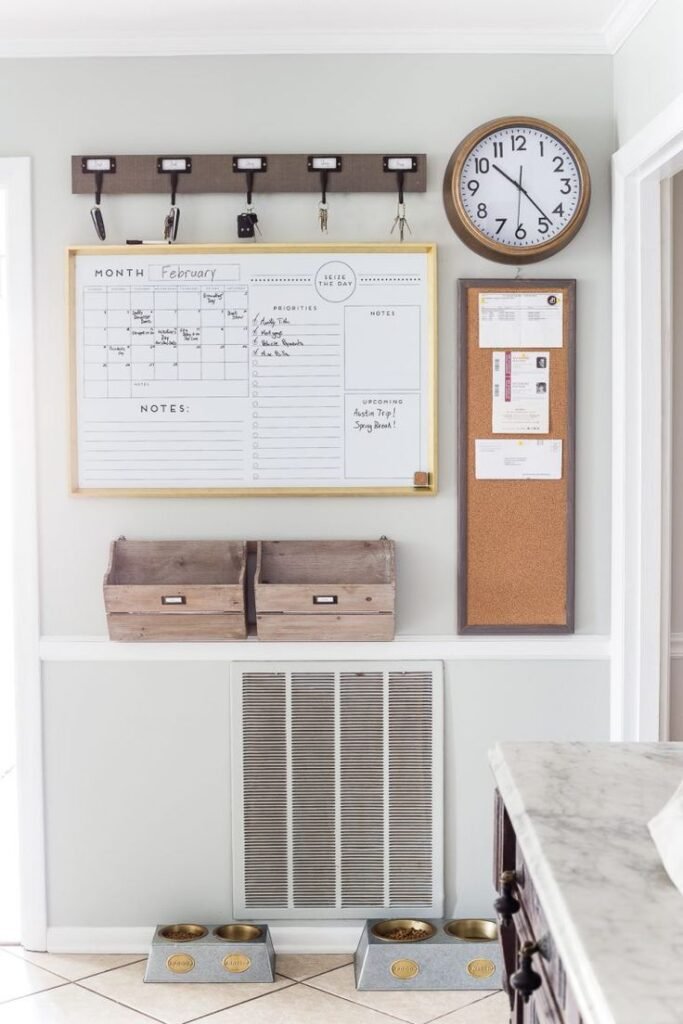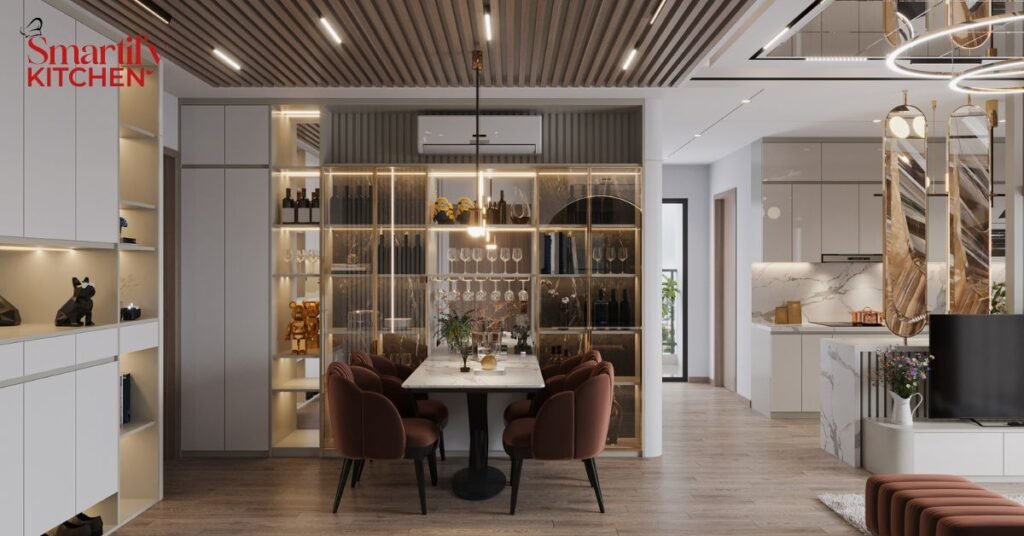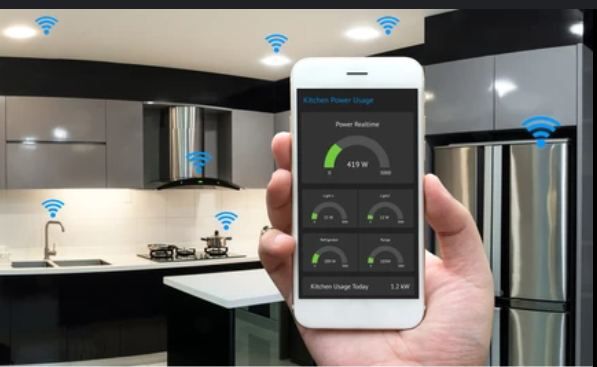How to Create a Smart Kitchen Command Center

The modern kitchen is no longer just a place for cooking; it has evolved into a hub for family activities, organization, and even entertainment. A smart kitchen command center can streamline these functions, providing a centralized hub for managing your kitchen and home tasks efficiently.
In A Hurry? Here is a Quick Review:
To create a smart kitchen command centre, start by planning a central hub with essential components like a smart display, voice assistant, and charging station.
Integrate smart appliances, ensure reliable Wi-Fi connectivity, automate routines, and prioritize safety, energy efficiency, and health tracking for a streamlined, futuristic kitchen.
How to Create a Smart Kitchen Command Center – Comprehensive Guide
This article will guide you through the steps to create a smart kitchen command centre, discussing the essential components, integration of smart appliances, connectivity, automation, safety features, energy management, and more.
Planning Your Smart Kitchen Command Center
Creating a smart kitchen command center starts with careful planning. Begin by assessing your needs and goals. What functions do you want your command center to perform?
Common goals might include managing grocery lists, controlling smart appliances, setting reminders, and accessing recipes. Determine which features are most important to you, and set a budget for your project. Keep in mind that while some smart devices can be pricey, there are also budget-friendly options available.
Essential Components of a Smart Kitchen Command Center

1. Smart Display or Tablet
A smart display or tablet serves as the central hub of your command center. Devices like the Amazon Echo Show, Google Nest Hub, or an iPad can display recipes, stream videos, make video calls, and control other smart devices. Choose a device with a screen size that suits your space and needs.
2. Smart Speaker or Voice Assistant
Voice assistants such as Amazon Alexa, Google Assistant, or Apple Siri can control your smart devices, set timers, play music, and answer questions. A smart speaker integrated with these assistants ensures hands-free operation, which is particularly useful in a kitchen environment.
3. Smart Hub
A smart hub connects all your smart devices, allowing them to communicate with each other. Popular smart hubs include Samsung SmartThings, Hubitat, and Amazon Echo Plus.
These hubs support various smart home protocols like Zigbee, Z-Wave, and Wi-Fi, ensuring compatibility with a wide range of devices.
5. Charging Station
A charging station keeps your smart devices powered and ready for use. Opt for a multi-device charging station to keep your tablet, smartphone, and other devices organized and charged.
Smart Appliances Integration
Integrating smart appliances into your command center enhances functionality and convenience. Here are some key appliances to consider:

A. Smart Refrigerator
A smart refrigerator can track food inventory, provide expiration date alerts, and suggest recipes based on available ingredients. Models like the Samsung Family Hub even feature built-in screens for streaming videos and displaying calendars.
B. Smart Oven and Microwave
Smart ovens and microwaves come with pre-programmed recipes, voice control, and automatic shut-off features. These appliances can simplify cooking and enhance safety. Brands like GE, LG, and Whirlpool offer a variety of smart cooking appliances.
C. Smart Dishwasher
Smart dishwashers offer energy-efficient settings, easy loading and unloading designs, and status alerts. These features help manage kitchen chores more efficiently. Bosch, Miele, and Samsung are known for their reliable smart dishwashers.
D. Smart Cooking Gadgets
Smart cooking gadgets, such as electric kettles, multi-cookers, and induction cooktops with safety features, can streamline meal preparation. Devices like the Instant Pot Smart WiFi and Tefal Cook4Me connect with apps to provide guided cooking steps and monitor progress.
Connectivity and Networking
Ensuring robust Wi-Fi coverage in your kitchen is crucial for the seamless operation of your smart devices. Consider the following:

I. Wi-Fi Coverage
Ensure your kitchen has strong Wi-Fi coverage by using mesh Wi-Fi systems like Google Nest WiFi or Eero. These systems eliminate dead zones and provide consistent connectivity throughout your home.
II. Smart Home Protocols
Integrate smart home protocols such as Zigbee, Z-Wave, and Wi-Fi to connect and control your devices. A smart hub can facilitate this integration, allowing different devices to communicate effectively.
III. Managing Connectivity
With multiple smart devices, managing connectivity becomes essential. Regularly update firmware and software to ensure compatibility and security. Use network management tools to monitor and prioritize device connections.
Automation and Control
Setting up automation and control features can make your smart kitchen command center even more efficient:
1.) Routines and Automation
Create routines and automations to streamline tasks. For example, set up a morning routine that turns on lights, brews coffee, and displays the weather forecast. Use apps like IFTTT (If This Then That) to link different devices and create custom automations.
2. )Voice Commands
Utilize voice commands through smart assistants to control your devices. Commands like “Hey Google, preheat the oven to 350 degrees” or “Alexa, add milk to my shopping list” can simplify your daily tasks.
3.) Remote Control
Control your smart kitchen devices remotely using smartphone apps. Most smart appliances come with dedicated apps that allow you to monitor and manage them from anywhere, providing added convenience and peace of mind.

Safety and Security Features
Enhancing safety and security in your smart kitchen command center is essential:
A) Monitoring and Alert Systems
Install monitoring and alert systems to detect potential hazards. Smart smoke detectors, like the Nest Protect, can send alerts to your smartphone if smoke or carbon monoxide is detected. Water leak sensors can alert you to leaks under the sink or dishwasher.
b ) Smart Sensors
Smart sensors can enhance safety by detecting unusual activity. For example, motion sensors can turn on lights when someone enters the kitchen at night. Temperature sensors can monitor oven and fridge temperatures, sending alerts if they deviate from safe ranges.
C) Security Cameras and Door Locks
Integrate security cameras and smart door locks to monitor your home. Cameras like the Arlo Pro or Ring Spotlight Cam can provide video feeds to your smart display. Smart locks, such as the August Smart Lock, can offer keyless entry and monitor access.
Energy Management
Implementing energy management solutions can help reduce energy consumption and save on utility bills:
⓵. Smart Lighting Solutions
Smart lighting solutions, such as Philips Hue or LIFX, allow you to control brightness and color settings. Motion-activated lights can turn on when you enter the kitchen, conserving energy when the room is not in use.

⓶. Energy-Efficient Appliances
Choose energy-efficient appliances that comply with Energy Star standards. Smart appliances often come with energy-saving modes and usage monitoring features, helping you track and reduce energy consumption.
⓷. Usage Monitoring
Monitor your energy usage with smart plugs and energy management apps. Devices like the TP-Link Kasa Smart Plug can track the energy consumption of connected appliances, providing insights into your usage patterns and identifying areas for improvement.
Health and Nutrition Management
Smart kitchen technology can also support health and nutrition management:
#1. Meal Planning and Recipe Apps
Use meal planning and recipe apps to organize your meals. Apps like Paprika, Yummly, and Tasty offer recipe suggestions, grocery list integration, and step-by-step cooking instructions.
#2. Dietary Tracking and Recommendations
Integrate dietary tracking features to monitor your nutritional intake. Devices like the Samsung Family Hub refrigerator can suggest healthy recipes based on your dietary preferences and health goals.
#3. Health Monitoring Devices
Synchronize your smart kitchen with health monitoring devices like smartwatches and fitness trackers. These devices can provide personalized health insights and recommend dietary adjustments to support your health.

Organizing and Design Tips
Proper organization and design can enhance the functionality and aesthetics of your smart kitchen command centre:
1. Central Location
Choose a central location in the kitchen for your command center. This spot should be easily accessible and have enough space for your smart display, charging station, and other devices.
2. Cable Management
Keep your command center neat and organized with cable management solutions. Use cable clips, sleeves, and organizers to prevent tangling and clutter.
3. Ergonomic Considerations
Ensure that your command center is ergonomically designed for easy access and use. Place frequently used devices at a convenient height and angle to minimize strain and improve usability.
Setting Up and Customizing Your Command Center
Follow these steps to set up and customize your smart kitchen command centre:
Step-by-Step Installation
- Set up your smart display or tablet: Position it in a central location and connect it to your Wi-Fi network.
- Install your smart speaker or voice assistant: Place it where it can easily pick up voice commands.
- Connect your smart hub: Follow the manufacturer’s instructions to connect and configure your smart hub.
- Integrate smart appliances: Connect your smart refrigerator, oven, dishwasher, and other appliances to your smart hub and voice assistant.
- Set up a charging station: Organize and connect your devices for easy charging.
Customizing Settings and Preferences
Customize the settings and preferences of your smart devices to suit your needs. Adjust notification preferences, create routines, and set up voice commands to streamline your kitchen activities.

Troubleshooting Common Issues
Address common issues such as connectivity problems, device compatibility, and software updates. Consult user manuals, manufacturer websites, and online forums for troubleshooting tips and solutions.
Real-Life Examples and Inspiration
Let’s Review some Life Examples now.
Case Studies of Smart Kitchen Command Centers
Explore case studies of the successful smart kitchen command centres for inspiration. Learn how other homeowners have integrated smart technology to enhance their kitchen experience.
Testimonials from Users
Read testimonials from users who have created smart kitchen command centers. Discover how these setups have improved their daily routines, enhanced safety, and increased convenience.
Future Trends in Smart Kitchen Technology
Let’s Review some of the Future Trends in Smart Kitchen Technology.
Advances in AI and Machine Learning
Advances in AI and machine learning are driving the development of more intuitive and personalized smart kitchen devices. Future innovations may include AI-powered appliances that learn your cooking habits and preferences, making meal preparation even more convenient.
Enhanced Integration with Other Smart Home Systems
Future smart kitchen technology will likely offer enhanced integration with other smart home systems, creating a more cohesive and connected home environment.
This integration will allow for seamless control of lighting, climate, security, and entertainment systems from your kitchen command center.
Emerging Technologies and Innovations
Keep an eye on emerging technologies and innovations in the smart kitchen space. Innovations such as robotic cooking assistants, advanced food sensors, and augmented reality recipe guides could revolutionize the way we interact with our kitchens.
Conclusion
Creating a smart kitchen command center can significantly enhance your kitchen’s functionality, safety, and convenience. By carefully planning and selecting the right components, integrating smart appliances, and implementing automation and control features, you can transform your kitchen into a central hub for managing your home.
As technology continues to advance, the possibilities for improving your kitchen experience will only expand, making now the perfect time to start planning and setting up your own smart kitchen command center.






